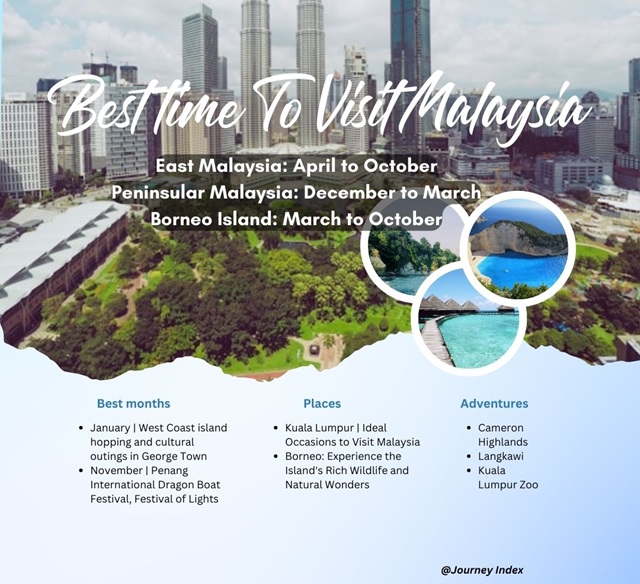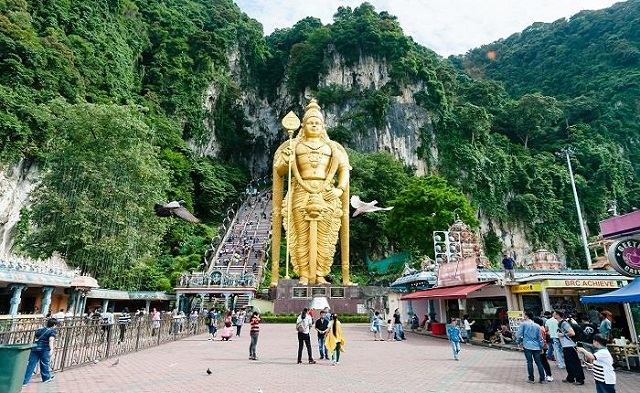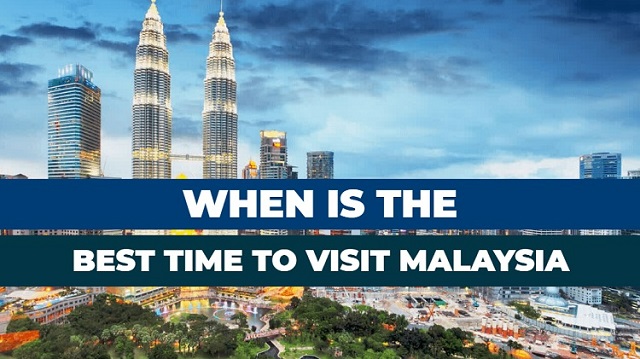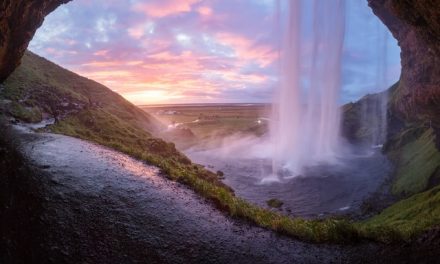Malaysia! It’s one of the most beautiful and visited countries in Asia. Also, if you are looking forward to visiting Malaysia soon and are confused about the best time of the year to visit Malaysia, read this article till the end to clear your mind. in this article, we will discuss the best time to visit Malaysia.
Malaysia is a country located on the southeast coast of Asia. It has a population of over 30 million and consists of 13 states and three union territories. The country is diverse in geography, climate, culture, and wildlife. Malaysia is a fascinating country with abundant natural resources and a rich cultural heritage. It offers many attractions to visitors, from tropical beaches to snow-capped mountains. The South China Sea divides mainland Malaysia into two regions: east (Borneo’s East Malaysia) and west (Peninsular Malaysia). It shares borders with Thailand, Singapore, Indonesia, and Brunei, and the Strait of Malacca separates Malaysia from Singapore.
Here Is A List Of The Best Times To Visit Malaysia
The best time to visit Malaysia is throughout the year, but Malaysia is divided into two regions. So, the best time to visit Malaysia is from April to October for the east coast and from December to March for the west coast. The best time to visit Borneo Island is from March to October. Malaysia is a country close to the equator, making it hot, humid, and pretty wet most of the year. Being a tropical location, sea temperatures are a lovely 28–30 °C throughout the year, perfect for a beach holiday.
- Best season to Visit Malaysia
- Best Months to Visit Malaysia
- Best Time to Visit Kuala Lumpur | Ideal Occasions to Visit Malaysia
- Best Time to Visit Borneo | The Island’s Rich Wildlife and Natural Wonders
- Best Time to Visit Festivals in Malaysia
The Monsoon Season Is The Best Time To Visit Malaysia
In Malaysia, there are two distinct monsoon seasons, each influencing the weather patterns across the region. These monsoons can vary in intensity and duration from year to year but generally bring strong winds and rough seas, particularly in the vicinity of the South China Sea. The term “inter-monsoon season” refers to the time between these monsoon seasons, which are marked, particularly in Peninsula Malaysia’s western areas, by serene mornings and afternoon thunderstorms. However, due to natural variations, the exact timing of these seasons can fluctuate annually. The Southwest Monsoon typically sets in around late May and persists until September. Although it is considered the drier monsoon, heavy rainfall still occurs on the West Coast and in Sabah, Borneo, during this period.
The Northeast Monsoon usually commences around November and extends until approximately March. This monsoon primarily affects specific regions, bringing heavy rain to the East Coast of Peninsula Malaysia and certain areas of Borneo, particularly the eastern regions of Sabah and the western part of Sarawak. Consequently, some islands in these areas may close during this time. However, alternative destinations on the Peninsula’s West Coast and in other parts of Borneo offer excellent options for travelers seeking to avoid the monsoon’s effects.

January | West Coast island hopping and cultural outings in George Town
Are you beginning your year in Malaysia? Smart choice. Opt for the west coast of the peninsula, as the east coast tends to be quite wet due to the northeast monsoon in January. If you’re fond of destinations like Langkawi and Penang for their stunning white-sand beaches and turquoise waters, you’ll find them especially delightful during this time. Additionally, certain parts of Borneo also make fantastic holiday destinations in January.
February | Chinese New Year & Jungle Exploration in Kota Kinabalu, Cameron Highlands Tours
February is an exciting time to visit Malaysia as the country celebrates Chinese New Year with spectacular fireworks and entertainment. Unsurprisingly, you can witness lively celebrations right here. During this month, Kuala Lumpur receives more sunshine and less rainfall than usual. Similarly, Kota Kinabalu in Borneo and the Cameron Highlands have a dry climate. These destinations experience low rainfall from February to March, which is an ideal time to explore the tea plantations and strawberry fields amidst the beautiful weather.
March | Spotting Whale Sharks and Orangutans in Borneo, Scaling Mount Kinabalu
March and April stand out as prime months for ascending Mount Kinabalu, so lace up your hiking boots. During this time, you’ll encounter fewer crowds, cooler temperatures, and diminished rainfall—a welcome relief when ascending over 4000 meters (13,435 feet). Across Malaysian Borneo, including regions like Kuching, Bintulu, and Sandakan, the weather tends to dry up considerably. Thus, March to October proves to be an opportune period for travel. It’s also an excellent time for optimal orangutan sightings, although migrating whale sharks are only present until May. Keep in mind that the Southwest Monsoon might make an appearance in March, potentially impacting conditions along the Peninsula West Coast.
April | Enjoy Beach Getaways on the East Coast of the Peninsula
As the northeast monsoon begins to wane in April, the Peninsula’s East Coast springs to life. Venture in search of breathtaking beaches in Kota Bharu, Redang Island, or the Perhentian Islands. Alternatively, take the opportunity to explore bustling markets or visit stunning natural attractions like the Gua Charas cave temples. With reduced rainfall, the wildlife of Borneo is also likely to make its annual appearance. Consider joining a wildlife tour to visit some of the country’s best animal conservation sites, such as the Sepilok Orangutan Rehabilitation Centre or the Bornean Sun Bear Centre, for excellent animal spotting opportunities.
May | Explore Gorgeous Beaches, Spot Whale Sharks and Orangutans in Borneo, Celebrate Vesak Day
The Peninsula’s East Coast becomes a hotspot from mid-May to the end of June, offering picturesque white sand beaches and a refreshing sea breeze that helps counteract the well-known East Asian humidity. During this time, local holidays are in full swing, leading to increased activity in popular destinations like Kuantan, Tioman Island, the Perhentian Islands, and Kota Bharu. For those observing the teachings of Buddha, May hosts Vesak Day, also known as Buddha Day. Participants can be observed adorning temples with flowers and offerings and partaking in processions while clad in white attire.
June | turtles on Lankayan Island, Conquer Mount Kinabalu, and celebrate Gawai Dayak (Sarawak)
In June signifies the driest period in Kuala Lumpur, although it will also be the hottest time of the year. Over on the East Coast, cities like Kota Bharu experience temperatures soaring up to a maximum of 33°C, epitomizing tropical living. Consequently, this time of year tends to be bustling with activity, lasting until August. However, Malaysia offers plenty of attractions to explore. In Borneo, Kuching enjoys its sunniest month, while Lankayan Island’s resident sea turtles emerge to greet visitors until September. Furthermore, Sarawakians celebrate a festival called Gawai Dayak in June to give thanks for a bumper harvest and a productive farming season.
July | diving in Borneo and George Town, UNESCO World Heritage Day
During the dry season in Borneo, which usually has calm seas and excellent visibility, diving and snorkeling enthusiasts can enjoy perfect conditions to explore underwater wonders. Also, in the city of George Town on the west coast of the island of Penang, UNESCO World Heritage Day is celebrated in July. Vibrant celebrations that highlight the island’s rich cultural heritage mark this special occasion. From traditional rituals to delectable foods, engaging games, and enlightening historical exhibits, the day serves as a colorful tribute to the diverse heritage of George Town and its people.
August | Lights and Water Festival and Malaysia National Day
In August, travel numbers remain high along the East Coast. As it’s still the middle of the dry season in Borneo, there are numerous well-known and off-the-beaten-track destinations to escape the holiday crowds. Consider embarking on a climb up Mount Kinabalu from June to September, experiencing the Borneo rainforest from a canopy walkway in Sepilok, or delving into cave exploration in Mulu National Park. It’s worth noting that agricultural burning typically commences in nearby Sumatra, Indonesia, during August, potentially carrying smoke and haze across the Malacca Strait to the West Coast of Peninsula Malaysia.
September | Borneo International Kite Festival, Mount Kinabalu Climb, Turtles on Lankayan Island, Mid-Autumn Festival
In September, it’s typically the last opportunity of the year to witness turtles on Lankayan Island. With the departure of holiday crowds, the East Coast tends to be quieter, making it an ideal time to indulge in clear-water snorkeling right off the beaches in the Perhentian Islands, particularly before the onset of the monsoon around November. Visitors during this month also have the chance to partake in unique Malaysian festivities such as the Mooncake Festival, also known as the Mid-Autumn Festival. This celebration often features a captivating River of Lights lantern parade in George Town and an array of culturally rich celebrations in Kuala Lumpur, along with various other festivities across the country.
October | Animal Spotting in Borneo
Savor October, the last month of Borneo’s dry season. Keep an eye out for orangutans during wildlife walks in Batang Ai National Park or on boat rides along the Kinabatangan River. With luck, you might even spot a pygmy elephant or proboscis monkey amidst the lush greenery. Alternatively, for those seeking relaxation, consider visiting the idyllic Manukan Island to experience your slice of paradise. Additionally, this month offers a last chance for prime vacationing on the East Coast before the weather turns wet and windy for the remainder of the year.
November | Penang International Dragon Boat Festival, Festival of Lights
The northeast monsoon usually sets in from November to February, often deterring visitors from the East Coast and sometimes Borneo. The weather on the west coast of the peninsula is mild and sunny, but being tropical, showers can occur at any time. With resorts on the eastern side of the island closed, the west coast is likely to be crowded. It offers the opportunity to explore the antique shops and night markets of Melaka, wander through the mossy forest of Butterworth or delve into Penang’s colonial heritage. Also, the annual International Dragon Boat Festival, a wonderful celebration of Asian culture from all over the world, is an added benefit for tourists during this month.
December | Adventures in the Cameron Highlands and Sunny West Coast Escapades
December is an ideal time to visit the Cameron Highlands. However, if you prefer a sun-and-sand holiday, consider fantastic destinations on the West Coast like Langkawi, George Town, or Pangkor Island, where you’ll enjoy warm seas, long sunny hours, and dry days (by Malaysian standards). Borneo typically experiences heavy rainfall and rough seas during this time, prompting many attractions to close as wildlife seeks shelter and tourism slows down.
Best Time to Visit Kuala Lumpur | Ideal Occasions to Visit Malaysia
In Malaysia, the Kuala Lumpur Occasion of Arts is a biennial celebration of art featuring performances by international artists. The event is held near various attractions, such as the Petronas Twin Towers and the Kuala Lumpur Zoo. Kuala Lumpur is well-connected to other parts of the country, making it an ideal hub for exploring Malaysia.
The city boasts numerous exciting attractions, including the Petronas Towers, the National Gallery, and the Perdana Botanical Gardens. The best time to visit Kuala Lumpur is generally between July and August, when rainfall is typically lowest, followed by January and February. Temperatures can reach around 35°C due to the urban heat effect, but on average, it’s a balmy 28°C.

Located in West Malaysia, Kuala Lumpur experiences a humid and hot equatorial climate with little variation throughout the year and no distinct dry season. The wettest months are typically from October to December, with monthly rainfall reaching up to 290mm (11.4in). Additionally, due to its proximity to the West Coast, the city may experience haze and smoke as a result of agricultural fires in nearby Sumatra, particularly in August and September.
Despite these factors, Kuala Lumpur offers a rich cultural and historical experience with a variety of attractions worth visiting. For Malaysia budget travel tips for first time visitors, there are plenty of indoor and outdoor activities to enjoy, making it an ideal destination for a vacation.
Best Time to Visit Borneo | Experience the Island’s Rich Wildlife and Natural Wonders
The best time to visit Borneo is from March to October, when it is relatively drier due to the Northeast monsoon season affecting the rest of the year. However, as Borneo is an equatorial rainforest island, it remains hot, humid, and rainy throughout the year.
March to October is also the best time to see orangutans in Borneo, as they are easier to spot during this period. Additionally, it’s the prime time for sighting pygmy elephants and proboscis monkeys. For snorkeling and diving enthusiasts, the best months are typically from July to August, when visibility is at its peak. However, April to November also offer excellent conditions and may be less crowded.
If you’re interested in marine life, June to September is the best time to view sea turtles on Lankayan Island, while migrating whale sharks can be spotted from March to May. It’s important to note that weather conditions may vary across different regions of Borneo, so checking specific destination forecasts before planning your trip is advisable.
Best Time to Visit Festivals in Malaysia
There are so many festivals in Malaysia! We have already covered many such events in the monthly visit list. Additionally, here is a list of some of the most popular ones to visit.
1. Hari Raya Puasa (Eid al-Fitr):
2. Rainforest World Music Festival, Kuching, Sarawak
3. Deepavali (Diwali)
4. Christmas
5. Thaipusam
Hari Raya Puasa (Eid al-Fitr)
This Muslim festival marks the end of Ramadan and is celebrated with great enthusiasm across Malaysia. It usually occurs between May and June, depending on the Islamic lunar calendar. During Hari Raya Puasa, Malaysians engage in feasting, visiting relatives, and giving to charity. The atmosphere is joyful, with vibrant decorations adorning homes and streets.
Rainforest World Music Festival, Kuching, Sarawak
The Rainforest World Music Festival takes place annually in Kuching, Sarawak, typically in mid-July. This renowned festival celebrates the diverse music and cultures of the world, with a focus on traditional and contemporary world music. Attendees can enjoy performances by international and local artists, workshops, and cultural displays set amidst the lush rainforest surroundings. The festival offers a unique opportunity to experience the vibrant rhythms and melodies from different cultures, making it a must-visit event for music enthusiasts and cultural explorers alike.
Deepavali (Diwali)
In Malaysia, the Hindu community celebrates Deepavali, also known as the Festival of Lights. It typically falls between October and November and is a time of illuminating homes with oil lamps, exchanging gifts, and enjoying traditional sweets. Visitors can witness colorful street decorations, vibrant cultural performances, and the mesmerizing sight of lit oil lamps adorning homes and temples.
Christmas
Despite the fact that Malaysia is primarily a Muslim country, people of all faiths continue to celebrate and embrace Christmas. Festive decorations adorn shopping malls and streets, and you’ll find special events and concerts held in major cities like Kuala Lumpur and Penang. Every year on December 25th, we celebrate Christmas.
Thaipusam
Thaipusam is a significant Hindu festival that the Tamil community in Malaysia celebrates, particularly in areas with sizable Indian populations like Kuala Lumpur, Penang, and Selangor. This festival usually falls in January or February, depending on the lunar calendar. During Thaipusam, devotees embark on pilgrimages to temples, the most famous being the Batu Caves in Kuala Lumpur.
Devotees often carry kavadis, which are elaborate structures decorated with various ornaments, flowers, and sometimes spikes or piercings. This kavadi is carried out as penance and acts of devotion. The atmosphere during Thaipusam is very lively and lively, with devotees chanting hymns, playing traditional music, and participating in various rituals throughout the procession. It is not only a religious event but also a cultural spectacle that attracts locals and tourists alike. Similarly, if you are looking for things to do in Malaysia, this article will provide you with a vibrant tapestry of cultural experiences to enjoy.
The capital of Malaysia is Kuala Lumpur. The country has over 300 different ethnic groups and languages spoken. Many tourist spots in Malaysia offer great views and exciting attractions for tourists. Malaysia is a beautiful country that has much to offer tourists. Here is a list of places to visit in Malaysia and the best times to go to experience them.
Conclusion
Finally, Malaysia is a beautiful country with much to offer tourists. The best time to visit Malaysia depends on what you want to do. If you’re looking for a good time to visit the beaches, Sepak Takraw is more than just a sport in Malaysia; it’s a reflection of the country’s rich cultural heritage and passion for athleticism. Whether you’re a spectator or a participant, experiencing Sepak Takraw in Malaysia is a unique and unforgettable part of the country’s vibrant sporting landscape.
Go during the winter, when it’s cooler. If you’re interested in exploring the jungle, go hotter and more humid during the summer. Regardless of when you go, be sure to enjoy all that Malaysia offers! Thanks for reading. Visit again here at Journey Index.





